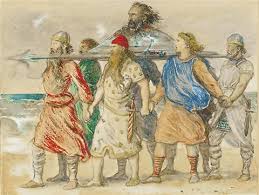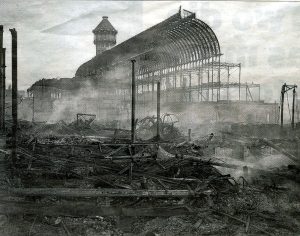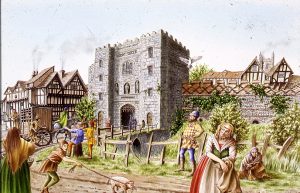
Some great photos of the lockdown here.


The Past brought to Life

An email from the British Library exhorting me to:

So I did. And what did I find?
A dullish page, but with hopefully many delights hidden in the links.
I began with an exploration of the architecture, which was just a bit of text with a few images. And, much to my delight a whopping typo when referring to the wrong Gilbert Scott as inspiration to the architect, Colin St John Wilson. 4 out of 10, I fear.
I then took a safe bet to look at the Virtual Books. I have long admired the ability to look through the books in the Treasures Gallery in digital form – mostly looking at the Lindisfarne Gospel, Leonardo Da Vinca, and Alice. So, I clicked the link, to another surprisingly dull page with only 6 books to excite. But I knew there must be more, and to the top right was a link to ‘View All‘. Clicking this revealed some of the wonders of the world of books; from a Ethiopian Bible, to Lewis Carroll’s handwritten Alice’s Adventures Underground to works by Jane Austen. Each one in blazing colour and which the visitor can zoom in on and thumb through.
Beautiful and I chose a Psalter that is annotated by Henry VIII’s himself. Wow!

Why, I wonder, do the British Library make so little of it? I only got to it as i knew that had it. Most would pass by.
This gets a 10 out of 10 for awe-inspiring content, and a 3 for hiding its light under a bushel.
Next, I was excited to see a exhortation to ‘Visit an Online Exhibition.‘ This was what I had come here for. Really, excited. When I got there, there were 44! I was really looking forward to this.
But they were not exhibitions, they were a series of articles and blog posts. All very interesting, and all illustrated with lots of images of beautiful objects. But in no-way an online exhibition.
So very disappointed.
Overall, the British Library web site has some absolutely marvellous stuff. But its not really digital, its just online. There is no feeling of a digital experience, digital content yes, a digital experience. no.
It should be a 10 out of 10, and it is for content but for a digital experience, I’m hard pressed to give it a 6.
This is an excellent resources with interesting information on historic taverns in London (and indeed all over).
This is a great find – very little neolithic pottery has been found in or near the City so this fills in a blank. It still doesn’t give us enough information to write authoritatively about the City before the Romans, but its a significant step forward.
Just some:
bob clip dance hornpipe leather pleasure roust sport stroke till trade trick bed foin foutre frig frisk have jape juggle jumble leap niggle nock occupy plough rifle seal sport swive thrum thump tick-tack till towze tread tumble twang vault wap.
source:
https://www.salon.com/2014/10/05/tickle_gizzard_and_the_pleasure_pivot_a_history_of_sex_slang_and_the_coolest_ancient_dirty_words/
I would rather be ashes than dust!
I would rather that my spark should burn out in a brilliant blaze than it should be stifled by dry-rot.
I would rather be a superb meteor, every atom of me in magnificent glow, than a sleepy and permanent planet.
The function of man is to live, not to exist.
I shall not waste my days in trying to prolong them.
I shall use my time.
said Jack London.
I would rather be earth than dust!
I would rather my spark should kindle a bright home fire than it should be stifled by dry-rot
I would rather be a vibrant planet every inch of me nurturing of life, than a superb meteor
The function of man is to create not to exist
I will live my life to prolong my creative days
I shall use my time
I responded.
Myths, Legends and the Origins of London
2.30 Sat 2 May 2020 Tower Hill Tube (meet by the Tower Hill Tram)
Please check that the walks have not been cancelled.

The Head of Bran by John Everett Millais
The walk is led by Kevin Flude, a former archaeologist at the Museum of London, and it looks at the archaeological evidence for the origins of London and reconsiders London’s myths and legends.
London has a rich set of origin myths and legends which are not as well known as they should be. This walk is designed to set that right and give an insight into London’s myths and legends.
Worth knowing for their own right do these origin myths have anything to say about the actual origins of London? This is what this walk explores. It is split into two halves – the first reveals the myths and the second finds out where the ‘truth’ of the origins of London may lie.
This is a London Walks Guided Walks. Look at their web site for a list of other of their amazing walks
The Archaeology of London Walk
2.30 pm Oct 31 20 St. Paul’s Tube Exit 2.
Legends said that London was founded in the Bronze Age. Historians wrote about a thriving Celtic City, followed by a Roman City which began with the building of a military Bridge shortly after the Invasion led by the Emperor Claudius in 43 AD. It survived till the Romans left and London suffered a Dark Age until the building of St Pauls cathedral in 604AD. The Saxon City began a continuous history as yet uninterupted.
This traditional story was challenged by archaeologists in the 20th and 21st Century and this walk will investigate their discoveries and visit the sites of Roman Forts/Amphitheatres/Temples/Roads/Houses and burials.
This is a London Walks Walk by Kevin Flude
Victoria & Albert & Albertopolis March 28 2020
2.30 High Street Kensington Tube
All London Walks have been cancelled until further notice due to Social Isolation
If this is a disappointment please email me and I’ll send you a print out.

On this walk we discover the story of the Great Exhibition of 1851 and the foundation of the one of the world’s Greatest Museums.
Led by Kevin Flude, who worked as an Assistant Keeper at the V&A, We begin in the new Victorian suburb of Kensington, prospering in the shadow of Kensington Palace, birthplace of Queen Victoria. We then explore the site of the Great Exhibition, and the great buildings inspired by Albert around the Albert Hall, before ending the walk with a tour of the Victoria and Albert Museum.
The area was originally part of the lowly area of Brompton until the huge success of the Great Exhibition created by Prince Albert and his right-hand man Henry Cole, the first Director of the V&A. The area became known as Albertopolis,as a memorial to a remarkable man, and a testament to the energy and wealth of Victorian England.
This is a London Walks Guided Walk by Kevin Flude
Medieval London Walk. April 18th 2.30
Liverpool St Bishopsgate Exit top of escalator
All London Walks have been cancelled until further notice due to Social Isolation
If this is a disappointment please email me and I’ll send you a print out.

A walk which explores London in the Middle Ages. By 1400 London was dominating the affairs of the Kingdom and was growing into a sophisticated medieval Capital. We begin in the extra-mural area amongst the Monasteries and burial grounds before entering the City via Bishopsgate. and to the site of one of the few remaining medieval Churches at St Helens. We then look at everyday life in the City in the main markets streets of Cornhill, Poultry, Bucklersbury and Cheapside before visiting the Guildhall and ending at the City Wall. We will walk in the footsteps of Geffrey Chaucer, in the muddy City Streets, exploring the unhealthy conditions and poverty amidst great riches and pageantry. We will see where the Italians, the German, the Dutch, the Jews, and the French lived cheek by jowl with native Londoners and immigrants from the Midlands.
This is a London Walks Guided Walk by Kevin Flude